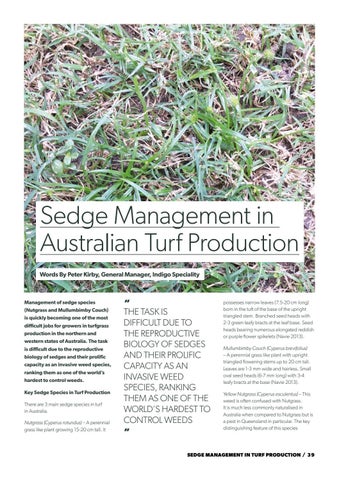Sedge Management in Australian Turf Production Words By Peter Kirby, General Manager, Indigo Speciality
Management of sedge species (Nutgrass and Mullumbimby Couch) is quickly becoming one of the most difficult jobs for growers in turfgrass production in the northern and western states of Australia. The task is difficult due to the reproductive biology of sedges and their prolific capacity as an invasive weed species, ranking them as one of the world’s hardest to control weeds. Key Sedge Species in Turf Production There are 3 main sedge species in turf in Australia. Nutgrass (Cyperus rotundus) – A perennial grass like plant growing 15-20 cm tall. It
“ THE TASK IS DIFFICULT DUE TO THE REPRODUCTIVE BIOLOGY OF SEDGES AND THEIR PROLIFIC CAPACITY AS AN INVASIVE WEED SPECIES, RANKING THEM AS ONE OF THE WORLD’S HARDEST TO CONTROL WEEDS ”
possesses narrow leaves (7.5-20 cm long) born in the tuft of the base of the upright triangled stem. Branched seed heads with 2-3 green leafy bracts at the leaf base. Seed heads bearing numerous elongated reddish or purple flower spikelets (Navie 2013). Mullumbimby Couch (Cyperus brevifolius) – A perennial grass like plant with upright triangled flowering stems up to 20 cm tall. Leaves are 1-3 mm wide and hairless. Small oval seed heads (6-7 mm long) with 3-4 leafy bracts at the base (Navie 2013). Yellow Nutgrass (Cyperus esculentus) – This weed is often confused with Nutgrass. It is much less commonly naturalised in Australia when compared to Nutgrass but is a pest in Queensland in particular. The key distinguishing feature of this species
SEDGE MANAGEMENT IN TURF PRODUCTION / 39
















